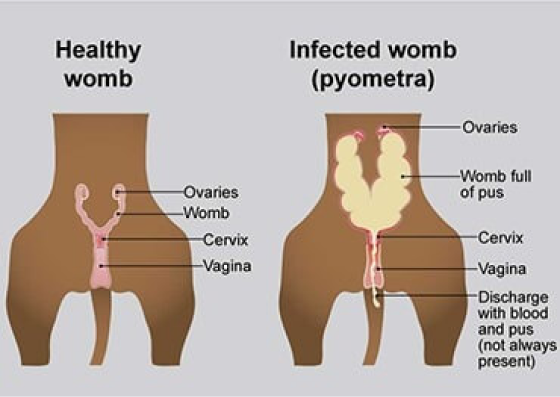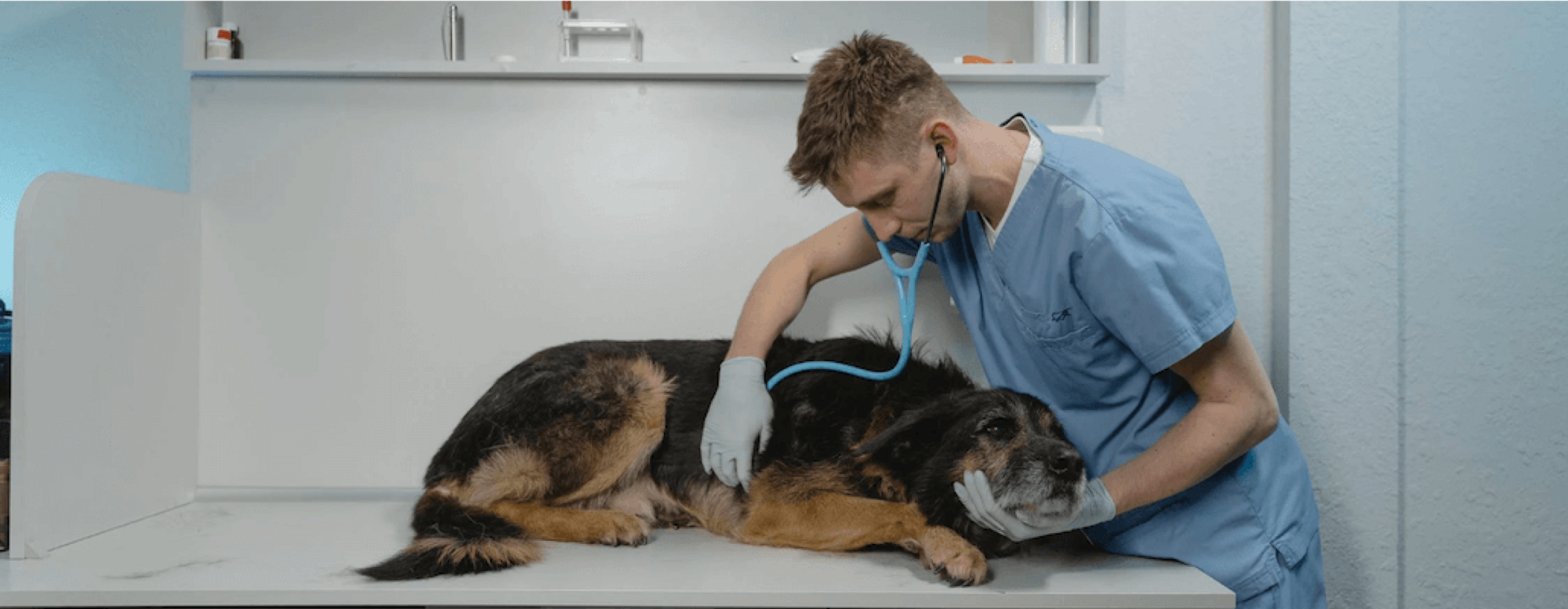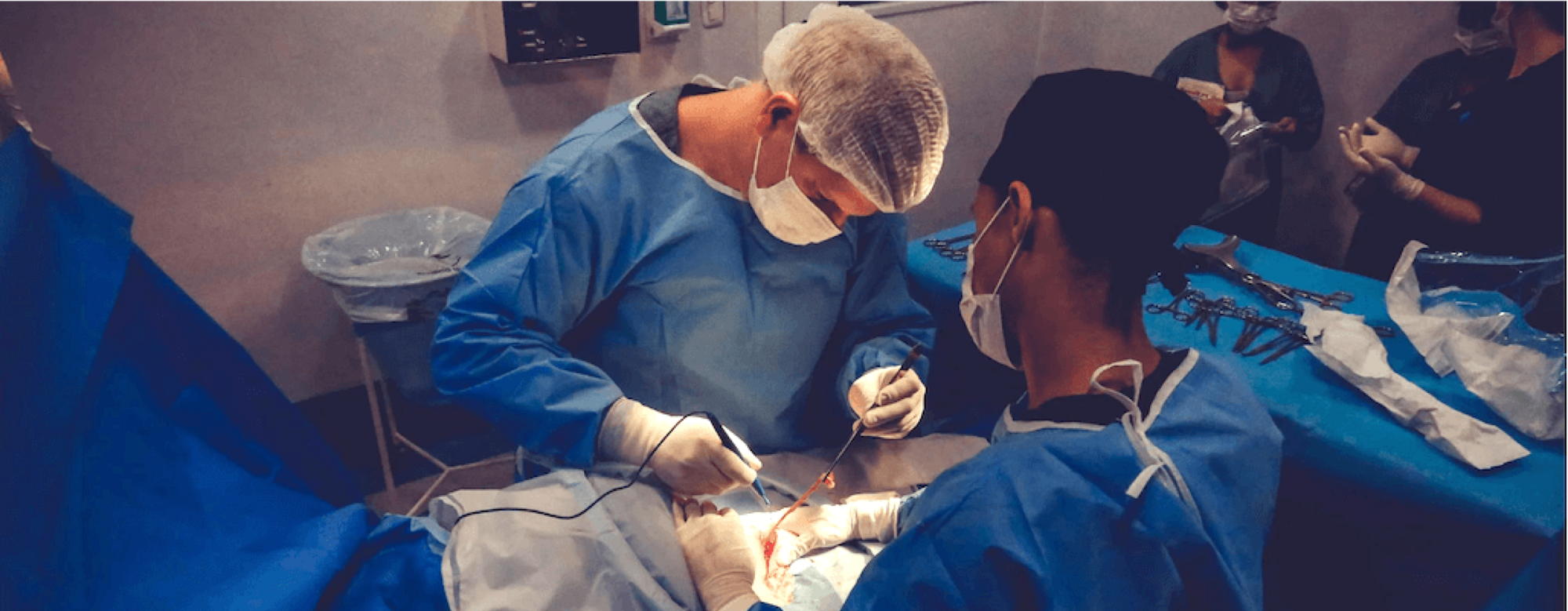Last Updated: 07/05/2025
Pyometra in Dogs
Are you aware of the risk of pyometra in your intact female dog? Take a read through our Vet-written guide for all you need to know.
Author: Dr Emilee Lay BVSc BSc (Vet) Hons
Reading Time: 19 minutes - medium read
Have you heard about Pyometra in dogs? Do you have an entire female dog at home and have read about them being at risk for it? Are you considering desexing your dog, and saw this was one of the diseases it can prevent? Read on to understand more about this life-threatening condition that can be seen in any sexually intact female dog.
Contents
What is Pyometra?

Source: PDSA
Pyometra is an infection of the uterus, brought about by hormonal changes that occur following a heat or "oestrus" in dogs. Following a heat or period, progesterone (a hormone produced by the body) stays elevated - preparing the uterus for pregnancy by helping to thicken the lining. With subsequent heat cycles (that aren't followed by pregnancy), the lining continues to thicken and form cysts which secrete fluids that create an ideal environment for bacteria to flourish.
What causes Pyometra in Dogs?
Bacteria that cause Pyometra, are normally found in the vagina and tend to take advantage of an ideal environment to grow. This ideal environment is created when the thickened and cystic uterine wall facilitate bacterial growth. A normal, healthy uterus is generally a hostile environment for bacteria. Bacteria enter the cervix - which is normally closed- during oestrus, where it stays open.
High levels of progesterone can also reduce the ability of the muscles of the uterus to contract, thus the uterus cannot expel the bacteria. The most common window of time for a Pyometra to occur is between 2-8 weeks after a heat.
Risk Factors for Pyometra
Being a female, entire dog is the main risk factor for Pyometra. This condition can occur at any age, but is more commonly seen in mature dogs. Dog's who have recently been mated or inseminated are also at risk. Dog's on progesterone and oestrogen based drugs are also at an increased risk of Pyometra.
Signs and Symptoms of Pyometra

There are two "types" of Pyometras - open and closed. Depending on the "type" the clinical signs can vary.
In an open pyometra, the cervix (the gateway to the uterus) stays open, allowing pus to drain from the uterus. This can simply appear as abnormal discharge from the vulva, following the end of a heat cycle. Female dogs with open pyometra do not necessarily have a fever, lethargy, loss of appetite or depression.
On the other hand when the cervix is closed i.e. a closed pyometra, the pus builds up in the uterus, which can cause the abdomen to appear bloated. The bacteria can enter circulation resulting in inappetance, lethargy, depression, vomiting and diarrhoea.
In both open and closed pyometra, toxins released by the bacteria can cause increased thirst and abnormal urine production due to their affects on the kidneys.

Discharge from the Vulva

Increased thirst

Increased urination

Lethargy

Inappetance

Vomiting

Diarrhoea

Distended, uncomfortable abdomen
Diagnosing Pyometra

Physical examination is always the first step in diagnosing any disease. Female, entire dog's who are displaying any of the clinical signs are always suspected of having a pyometra, especially if they have come off of a heat or have a painful, enlarged abdomen.
Bloodwork of affected dog's may show an elevated white cell count with elevated protein markers associated with the immune system. The urine may also be quite diluted. However imaging in the form of an X-ray or ultrasound is far more diagnostic, as it can show an enlarged fluid filled uterus.
Treatment of Pyometra in Dogs

Surgery
As Pyometra can be a life threatening condition - the most effective treatment that minimises risks is surgery to remove the ovaries and the uterus - much like in a spay or ovariohysterectomy. However, this surgery is complicated by the fact that many dogs are unwell, or have an overly large pus filled uterus, extra care, hospitalisation and surgery time are needed in order to safely remove it and keep your dog stable. A course of antibiotics is sometimes needed post operatively. Desexing your female dogs is the best way to prevent a pyometra from occurring.
What happens if I want to breed from my dog in the future?
Surgery is the main treatment for Pyometra. Although there are medical approaches their success rate is variable, and carry an increased risk of long-term complications. Prostaglandins are hormones that can be used to lower progesterone thus opening the cervix, relaxing and contracting the uterus to expel out the pus. These hormones can have significant side effects and are not suitable for dogs who are severely unwell. There is also a risk of the uterus rupturing as it contracts - especially if it is a closed pyometra.
Speak to your vet about the success rates, likelihood of reoccurrence and the ability to breed in the future if electing for medical management.
Prevention of Pyometra in Dogs

How to prevent Pyometra in dogs
Desexing your female dog - completely eliminates and prevents pyometra. Desexing can be done from six months of age, or if your dog has recently had a heat then about 2 months after the end of her season. Check out our article on "Desexing - Everything You Need to Know" to find out more.
What about dogs that have been recommended to delay their desexing?
There have been some recent studies suggesting potential benefits for delayed desexing in certain breeds (namely large and giant breeds) of dogs. This is a discussion to have with your vet, weighing up the pros and cons of delayed desexing. Dr Abbie Tipler has a great article on this topic - which can be found here.
Want to know more?
After more information about taking care of your dog with arthritis? Check out our video and additional articles below:
Desexing Your Pet: Everything You Need to Know
